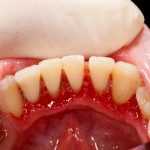
Facilitating the patient achieve high levels of supragingival plaque control and establishing high levels of adequate infection control are important in the management of periodontitis. The aim of subgingival instrumentation is to remove hard deposits and disrupt the microbial biofilm reducing the bacterial load and helping to suppress soft tissue inflammation.
The overall aim of this review was to evaluate the efficacy of subgingival instruments for the treatment of periodontitis.
Methods
Patient reported outcomes in patients with periodontitis in relation to 3 questions were considered: –
- Subgingival compared with supragingival instrumentation or prophylaxis
- Sonic/ultrasonic instruments compared to hand instruments or a combination of hand and sonic/ultrasonic instruments.
- Full mouth delivery protocols (within 24 hr) in compared to quadrant or sextant wise delivery.
Searches were conducted in the Cochrane Central Register of Controlled Trials (CENTRAL), MEDLINE (OVID), EMBASE, SCOPUS, and LILACS databases. Randomised controlled trials (RCTs) conducted in patients over the age of 18 relevant to the 3 questions and published in English were considered. Two reviewers independently screened and selected studies extracting data into a specifically developed spreadsheet with risk of bias being assessed using the ROBINS-I Tool. The primary outcome was reduction of PD expressed in mm with Clinical attachment level (CAL) and bleeding on probing (BOP) as secondary measures. Patient-reported outcome measures (PROMs) were also noted together with adverse events recording. Mean values and standard deviations were used for continuous data and analysed using weighted mean differences (WMD) and 95% confidence intervals (CIs). Dichotomous data was expressed as risk ratios (RR) with 95% CIs. Data were pooled using the random-effect model and grouped by pocket depth (all, shallow (4–6 mm) or deep (≥7 mm)) and tooth type (all, single- or multi-rooted).
Results
- 19 studies published between 1988 and 215 were included.
- 6 studies were considered to be at low risk of bias, 12 at unclear risk and 1 at high risk.
- Question 1 was only addressed specifically by one study suggesting a significant benefit for pocket closure at 3 months.
- Using separate baseline and final recording data (9 studies) the WMD for PD = 1.0mm (95%CI; 0.8 – 1.3) at 3 to 4 months and 1.4mm (95%CI; 1.0 – 1.7) at 6 to 8 months and pocket closure = 57% (95%CI;46 – 68%) at 3 to 4 months and 74% (95%CI: 64; 85%) at 6 to 8 months
- Question 2 was addressed by 6 studies and meta-analysis was only possible for PD reduction and CAL gain
- No significant differences were observed between treatment groups at any time point or for different categories of initial pocket depth
- Question 3 was considered by 13 studies and meta-analysis was only possible for PD reduction and CAL gain
- No significant differences were observed between treatment groups irrespective of time point or initial pocket depth
Conclusions
The authors concluded: –
..mechanical subgingival instrumentation is efficacious in the nonsurgical treatment of periodontitis, irrespective of type of instrument or mode of delivery.
Comments
While a good range of databases were searched restricting inclusion to those published in English may have excluded some relevant studies. As the authors point out the studies were rarely followed up for longer than 6 months and non-surgical periodontal treatment is likely to be part of a longer-term strategy for the maintenance of periodontal health. It was also noted that the majority of the included studies were institutionally based so may not be generalisable to primary care. The review suggests that there was no difference in PD or CAL with sonic/ultrasonic instruments compared to hand instruments or a combination of hand and sonic/ultrasonic instruments and no differences between full mouth and quadrant based protocols.
Links
Primary Paper
Suvan J, Leira Y, Moreno Sancho FM, Graziani F, Derks J, Tomasi C. Subgingival instrumentation for treatment of periodontitis. A systematic review. J Clin Periodontol. 2020;47 Suppl 22:155-175. doi:10.1111/jcpe.13245
Other references
Dental Elf – 27th Oct 2015
Dental Elf – April 23rd 2015
